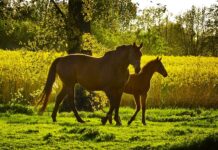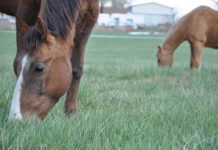I have two horses on an acre of pasture grass. I supplement them with hay, but I’m wondering if you can give me some pointers on pasture management?
Horses should consume at least 1.5 to 3 percent of their body weight per day in feed, and at least 70 percent of this feed should be available as long-stem forage from pasture and hay.
Well-managed pastures provide many advantages, including:
• Reduction in feed bills
• Opportunity for equine exercise and social interaction
• An aesthetically pleasing environment
• Increased forage production and grazing capacity
• Decreased erosion, which also leads to better surface and groundwater quality
Here are some tips to improve your pasture’s quality:
Fertilize periodically. Fertilizing is a very important component of pasture management. It is always advisable to conduct a soil test on pastures before applying fertilizer so that you only apply needed nutrients. A soil test kit can be obtained from your local cooperative extension office.
Control weeds. Prevention is the most cost-effective method of weed control. Bare areas in pastures provide a perfect environment for weed seed germination and weed establishment. The best defense against weeds is to maintain a thick, healthy growth of pasture grasses that can compete with weed seedlings.
If weeds become a persistent problem, herbicides can be used to control them. When using herbicides, it is important to follow all label directions and restrictions. Weeds should be identified carefully in order to choose the correct product. Since new weeds will often fill in the spaces created when herbicides are used, it is important to correct the conditions that created the weed problem in the first place and overseed pastures when necessary.
Create exercise areas and paddocks. It is important to decide if the primary function of the turnout area is for exercise or nutrition. If less than 1.5 acres of pasture are available per horse, the grasses will not be able to remain productive under continuous grazing conditions. Pastures under heavy grazing pressure will quickly be reduced to exercise lots. If more than 2 acres of pasture are available per horse, enough forage can usually be maintained to serve as a major nutritional source.
Manage grazing. Continuous and rotational grazing are two types of grazing systems. Continuous grazing generates greater stress on pasture systems than rotational grazing. Horses are spot grazers and will graze in preferred areas on specific forage species. When horses graze repeatedly on the same plants, carbohydrate reserves are depleted, new leaf tissue doesn’t grow, and the plants are eliminated from the pasture. Intensive grazing means the loss or lowered yields of desirable species of forages and the proliferation of undesirable weeds.
Rotating pastures greatly increases productivity by allowing time for plants to replace leaf tissue, and replenish carbohydrate levels lost in grazing. Rotational grazing requires more time, labor, fencing and water. However, the increased productivity offsets the increased costs.
For more information on pasture management, contact your local cooperative extension office.
Authors Carey Williams, Ph.D., equine extension specialist, and Donna Foulk, senior agriculture program coordinator, are based at Rutgers University, Equine Science Center.







Great tips!